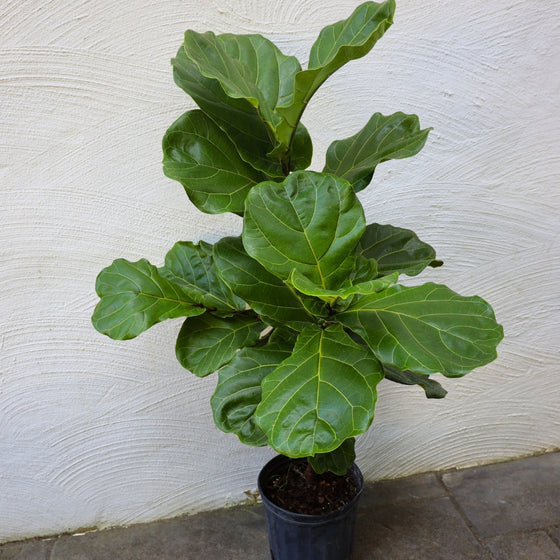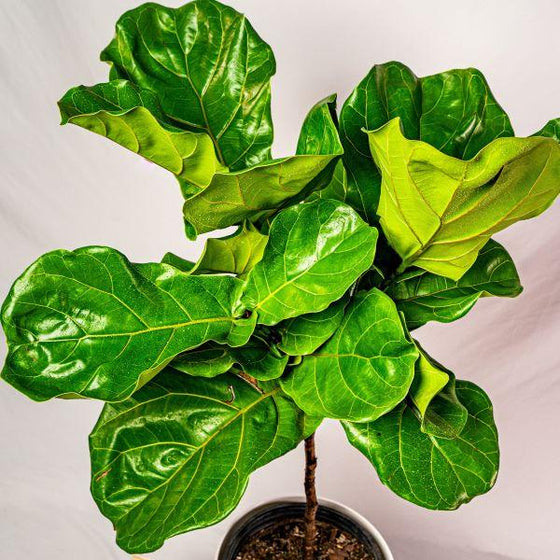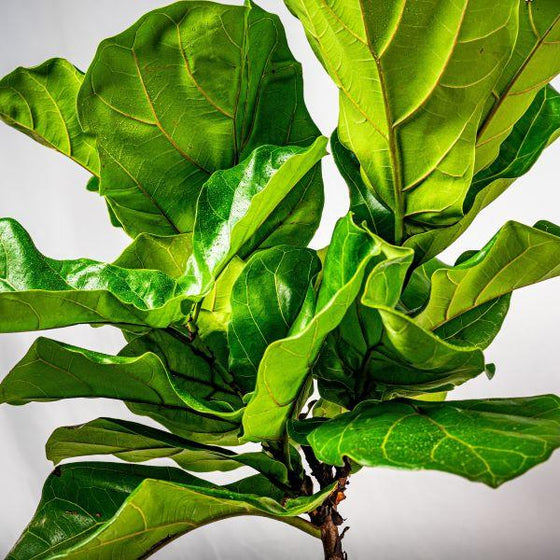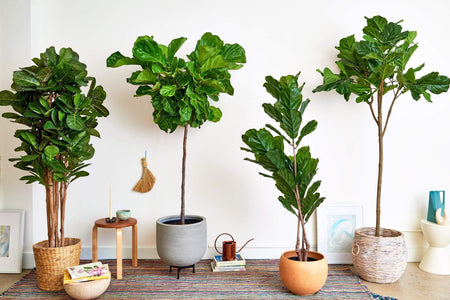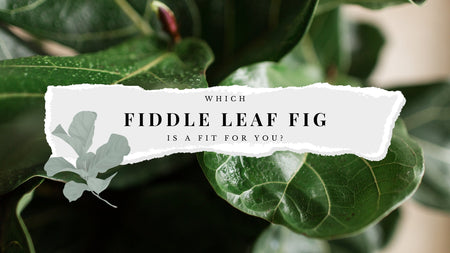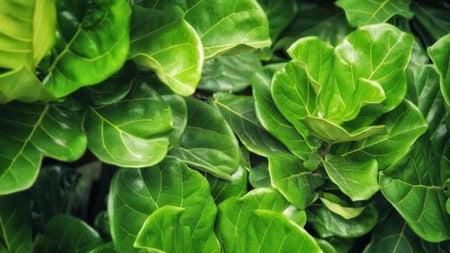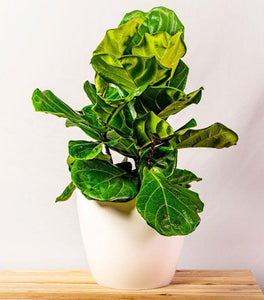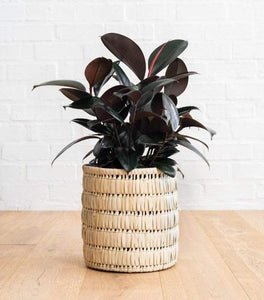
Images Depicted Range in Maturity & Container Size
Pots & Decorations Not Included Unless Otherwise Stated
Fiddle Leaf Fig Tree for Sale Online
The Fiddle Leaf Fig Tree (Ficus lyrata) is a striking houseplant known for its large, glossy leaves resembling a fiddle, adding an architectural element to any indoor space. With its tall, upright growth habit and broad, rich green leaves, the Fiddle Leaf Fig Tree makes a bold statement, perfect for creating a focal point in living rooms, offices, or entryways. This popular indoor plant can reach heights of up to 6 to 10 feet when grown in optimal conditions, making it an excellent choice for filling vertical space and adding natural beauty to modern interiors.
Fiddle-leaf Leaf Fig Trees thrive in bright, indirect light and prefer a consistent environment free of drafts and sudden temperature changes. To keep the foliage looking vibrant, place the plant near an east or west-facing window where it can receive plenty of filtered sunlight. Proper watering is critical—allow the top few inches of soil to dry out between waterings, ensuring that the plant has time to absorb moisture without becoming waterlogged. Regularly dusting the leaves will help maintain their shine and encourage efficient photosynthesis, supporting healthy growth. With a bit of care, the Fiddle Leaf Fig Tree can flourish for years, adding elegance and greenery to your home.
Aside from its stunning appearance, the Fiddle Leaf Fig Tree also offers air-purifying benefits, improving indoor air quality by removing toxins and releasing oxygen. This versatile plant works well with many decor styles, from minimalist and modern to bohemian and eclectic. Its bold leaves create visual interest and bring the tranquility of nature indoors, making it a popular choice for plant enthusiasts and interior designers alike. Whether you're an experienced plant owner or just beginning your indoor gardening journey, the Fiddle Leaf Fig Tree will surely add sophistication and lush greenery to your space.
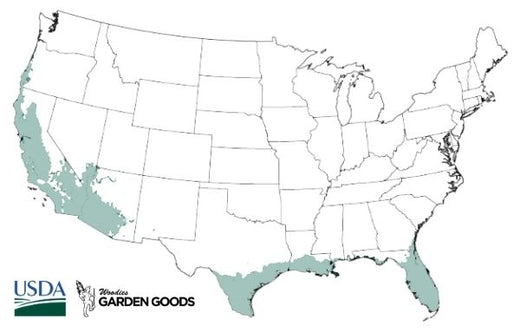
| Hardiness Zone: | 9-11 |
|---|---|
| Mature Height: | 6 to 10 feet indoors |
| Mature Width: | 3 to 4 feet indoors |
| Classification: | Indoor tree |
| Sunlight: | Bright indirect light |
| Habit: | Tree form, clear trunk |
| Foliage: | Green, shiny, smooth, violin-shaped |
| Soil Condition: | Balanced potting soil with good drainage, Likes to dry out between watering |
| Water needs | Allow soil to dry between waterings, keep air around leaves humid if possible |
| Uses: | Attractive plant to be featured or in the background of any room in the house |
How to Care for Fiddle Leaf Fig Tree
Be sure to read our planting instructions to ensure a healthy and happy Fiddle Leaf Fig tree for years to come!

What is the best light for a Fiddle Leaf Fig Tree?
The best light for a Fiddle Leaf Fig Tree is bright, indirect sunlight, which allows its large, glossy leaves to thrive and maintain their vibrant green color. Ideally, place your Fiddle Leaf Fig near an east or west-facing window, where it can receive plenty of filtered light throughout the day. A south-facing window can also work, as long as the plant is protected from harsh direct sunlight, which can scorch its sensitive leaves. If natural light is insufficient, especially during winter months, you can supplement with a grow light to ensure the plant gets enough brightness to stay healthy and vigorous. Fiddle Leaf Fig Trees require a consistent light source to grow well and develop their iconic, broad leaves. Too little light can result in leggy growth, smaller leaves, or leaf drop, while too much direct sunlight may cause brown spots or burned foliage. Rotate the plant every few weeks to ensure that all sides receive equal exposure to light, promoting even growth and a full, balanced shape. With the right lighting conditions, your Fiddle Leaf Fig Tree will grow strong, showcasing lush foliage that makes a stunning statement in any indoor space.
How often should I water a Fiddle Leaf Fig Tree?
Watering a Fiddle Leaf Fig Tree properly is crucial for its health and vibrant appearance. Generally, you should water your Fiddle Leaf Fig once every one to two weeks, allowing the top 2 to 3 inches of soil to dry out between waterings. The frequency may vary based on factors such as temperature, humidity, and light conditions in your home. During the growing season, typically spring and summer, the plant may require more frequent watering due to increased growth and higher evaporation rates. Always check the soil moisture before watering, as overwatering can lead to root rot, which is a common issue for Fiddle Leaf Fig Trees. In the cooler months of fall and winter, reduce the frequency of watering, as the plant's growth slows down and it requires less moisture. Make sure to use a pot with good drainage, as Fiddle Leaf Figs do not like to sit in standing water, which can lead to yellowing leaves and fungal problems. Water the plant thoroughly until excess water drains from the bottom, ensuring the entire root system gets hydrated. By maintaining a consistent watering schedule and adjusting based on the season, you can keep your Fiddle Leaf Fig Tree healthy, with lush, glossy leaves that make a beautiful addition to your indoor space.
How do I fertilize Fiddle Leaf Fig Trees?
Fertilizing a Fiddle Leaf Fig Tree is key to promoting healthy growth and vibrant foliage. During the growing season, typically from spring to early fall, feed your Fiddle Leaf Fig every four to six weeks with a balanced, water-soluble fertilizer, such as a 3-1-2 NPK ratio, which is ideal for this plant’s needs. The higher nitrogen content encourages lush, green leaf growth, while the phosphorus and potassium support overall health. Dilute the fertilizer to half the recommended strength to avoid burning the roots and apply it directly after watering, as this helps prevent fertilizer burn. Fertilizing during the active growth period will help maintain the large, glossy leaves for which Fiddle Leaf Figs are known. In fall and winter, reduce or stop fertilizing altogether, as the plant's growth naturally slows down. This dormant period allows the Fiddle Leaf Fig to rest without requiring additional nutrients. If the plant is showing signs of nutrient deficiency, such as pale or slow-growing leaves, you can supplement with a light application of fertilizer during the winter, but generally, it's best to resume feeding in spring. For an organic alternative, consider using compost or a seaweed-based fertilizer, which can gently enrich the soil without causing harm. By following a proper fertilization routine, your Fiddle Leaf Fig Tree will continue to grow robustly, featuring the lush and healthy foliage that makes it a popular choice for indoor gardening.

What is the best soil for a Fiddle Leaf Fig Tree?
The best soil for a Fiddle Leaf Fig Tree is one that is well-draining yet retains enough moisture to keep the roots hydrated. A high-quality potting mix that includes a blend of peat moss, pine bark, and perlite or vermiculite works well for Fiddle Leaf Figs, as this combination ensures good aeration while retaining the right amount of moisture. Peat moss helps hold moisture without becoming waterlogged, while perlite or vermiculite improves soil structure and drainage. You can also use a potting mix specifically formulated for houseplants or indoor trees, as long as it offers sufficient drainage. Proper soil ensures that the roots receive adequate oxygen and prevents the risk of root rot, which is a common issue with this plant if the soil stays too wet. In addition to using the right soil mix, it is essential to plant your Fiddle Leaf Fig Tree in a pot with drainage holes to allow excess water to escape. This prevents the soil from becoming saturated and promotes healthier root growth. If you notice water sitting in the bottom of the pot, consider using a layer of gravel or small rocks beneath the soil to further improve drainage. Fiddle Leaf Fig Trees are sensitive to both overwatering and compacted soil, so it's essential to periodically check the soil condition and ensure it's not becoming dense or waterlogged. By providing your Fiddle Leaf Fig with the ideal soil environment, you will encourage robust growth, strong root development, and the beautiful, glossy leaves that make this plant a popular indoor choice.

